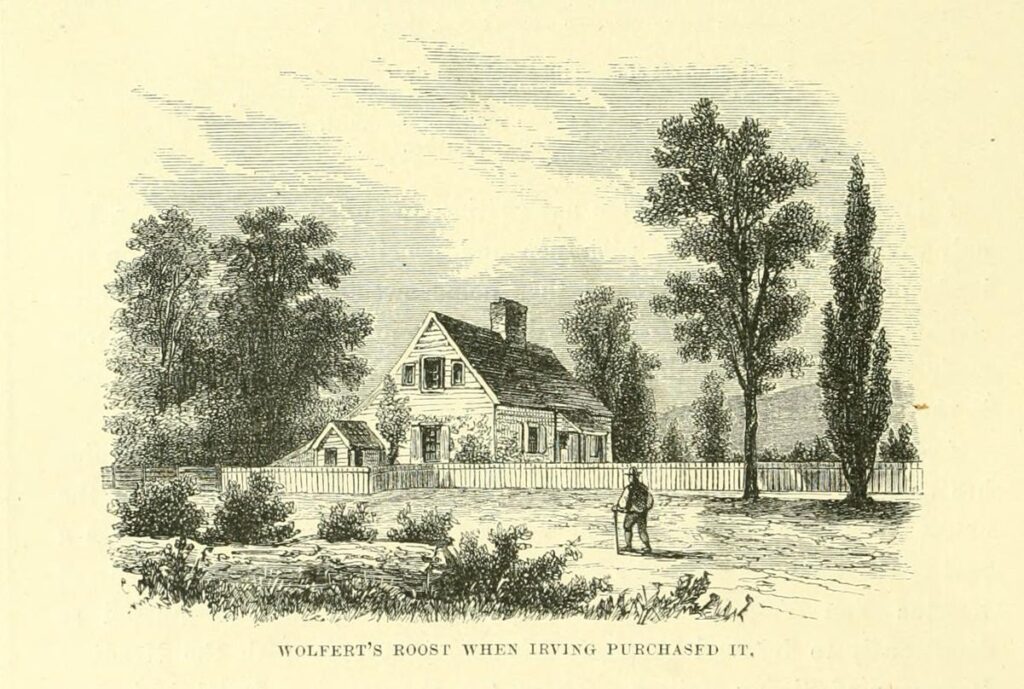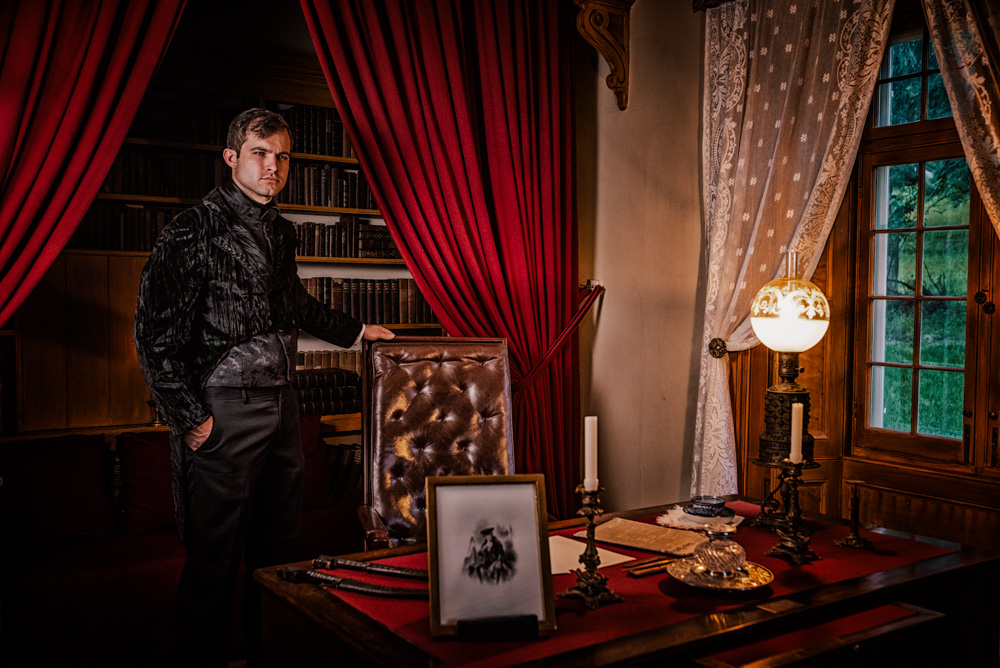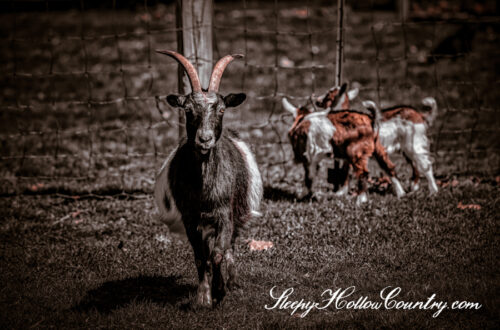
Sunnyside: Mr. Irving Builds his Dream House
“I am more and more in the notion of having that little cottage below Oscar’s house, and wish you to tell him to endeavor to get it for me. I am willing to pay a little unreasonably for it, and should like to have it in time to make any alterations that may be advisable, as early as possible in the spring.”
The Life and Letters of Washington Irving, Vol. 3, pg. 30.
Dutch immigrant Wolfert Acker lived in a modest farmhouse that was part of the many tenant properties on the Philipse Manor. It was situated on the Hudson River in a small hollow in the land on a cove. A bubbling and lively brook ran down the hill behind it. Constructed of stone, the house had a central chimney, steep gabled ends, and two rooms. It was accompanied by a few farming outbuildings. Locals say that the Acker farmhouse was erected sometime between the middle and the end of the 17th century, although no one could truly say for sure; as far as they knew, it had always been there.
The Van Tassell family married into the Acker family, took up residence in the cottage, and lived there until the very early 19th century. It was this very family, that a young Washington Irving was introduced to the first time he explored the hills and valleys of Sleepy Hollow Country as a lad of fifteen. He wouldn’t return for another 30 years, but that stone farmhouse and its idyllic location never left his mind.

Contents
Irving Settles Down and Builds Up
Irving spent most if not all of his adult life traveling starting in about 1809. By the time he had returned from a decade-long visit to England in 1832, he was yearning to settle down. After his return, Irving went to visit his brother Ebenezer in Tarrytown, and that quaint Van Tassell farmhouse was suddenly a shining beacon in his mind’s eye. This was the place where he could build a quiet life and finally settle in middle age. This was where he could spend the rest of his years.
Another spate of traveling took up Irving’s time, but by the spring of 1835, the Van Tassell Farm was officially in his possession. He writes to his brother, Peter:
“It is a beautiful spot cabable of being made a little paradise. There is a small stone Dutch cottage on it built about a century since…I have had an architect up there and shall build upon the old mansion this summer. My idea is to make a little nookery somwhat in the Dutch style, quaint but unpretending. It will be of stone. The cost will not be much I do not intend to set up any establishment there, but to put some simple furniture in it and keep it as a nest to which I can resort when in the mood.”
The Life and Letters of Washington Irving, Vol. III, pg.75

Irving employs nearby English artist, and friend George Harvey, to oversee the work and through the end of 1835, workmen continue to amend the cottage for Irving, who delights in seeing its progress and reports regularly to his family how pleased he is with his purchase and how special it is to him. The small two-room cottage is thus expanded from the original two rooms to a larger home with a second floor, highly stylistic Dutch-style stepped gables, a projecting entryway, a river-facing piazza, and stylistic flourishes reminiscent of the romantic and revival movements he saw while in England.
Irving modestly refers to it as “…a quaint and picturesque little pile” where he “…intend[s] to write a legend or two about it and its vicinity by way of making it pay for itself.” An inscription stone on the porch still sits bearing the name of Harvey, which Irving had engraved as “Geo. Harvey, Bou. Mst.” (Bou. Mst. translates to Boumeester, Dutch for Architect).
From Roost to Sunnyside
It wouldn’t be fully habitable and decorated with furniture until December of 1836, more than a year from the initial purchase. Irving named his little domicile the “Roost” and immediately installed his brother Peter in one of the rooms and regularly had his family over to visit with him. He also was briefly invaded by geese during a self-proclaimed “goose war”, took ownership of a “darling” sow pig named Fanny of “peerless beauty”, and enjoys the company of his cat, Imp, who joins him on his lap during his stretches of writing; of which he proclaims he has been doing almost “incessantly”. He is also insistent on replacing a broken weathervane that was knocked off the cottage.
“Seriously I am living most cosily and delightfully in this dear bright little home which I have fitted up to my own humor. Everything goes on cheerily in my little household and I would not exchange the cottage for any chateau in Christendom.”
The Life and Letters of Washington Irving, vol. III, pg. 92.
Sometime in the early 1840s, around the time his brother Ebenezer’s family moves in with him permanently, Irving’s “Roost” becomes “Sunnyside”. While the exact reasoning for the name change is unknown, it is supposed that he first came across the moniker during his time in England and his visit to Abbotsford, Sir Walter Scott’s castle in 1817.
Alas, Irving would be pulled away from his paradise with his confirmation as Minister to Spain in 1842. He charges his remaining brother, Ebenezer, to mind the little estate while he is away and laments leaving, but knows that it will be in good hands and well cared for. He would not return for four years.

Outward Expansions
Upon Irving being reunited with his little cottage in 1846, he immediately begins work on expanding it as what was once charming and cozy had become somewhat cramped with a portion of his family still residing there, and a need for guests and servants. There would be an addition of rooms on the rear of the house (the north) and also a large tower with a gracefully sloped roof with a pointed cupola:
“…It is one of the most useful addtions that ever was made to a house, besides being so ornamental. It gives me laundry, store rooms, pantries, servants’ rooms, coal celler, &c., &c., &c., coverting what was once a rather make-shift little mansion into one of the most complete snuggeries in the country…The only part of it that is not adapted to some valuable purpose is the cupola, which has no bell in it, and is about as serviceable as a feather in one’s cap; though, by the way, it has its purpose, for it supports a weathercock…”
The Life and Letters of Washington Irving, pg. 403.

In early summer, June of 1847, the work is complete and Irving revels in his writing study and library being finished and his books finally out of storage. He also has trees cut down on the grounds to allow for more open air and views of the river, hills, and surrounding scenery. His hand composed not just the house, but all parts of the landscape of the property, creating a scenic vision of his ideals.
Throughout the summer and into the fall of 1847, he would continue to amend Sunnyside, by creating an enclosed kitchen yard, a new stable yard, adding outbuildings, other farm structures, and a deeper ice pond, which would come to be known as “Little Mediterranean” with connecting streams and waterfalls.

Last Changes, Last Years
Irving as a “sober, quiet, good-for-nothing old gentleman” still found time to socialize in New York City. Travel always occurred by boat, from either nearby Tarrytown or Dobbs Ferry docks, but with the 1850s and the advent of the railroad on the horizon, Irving was very reasonably dismayed about the encroachment of industrial travel on his little cove of tranquility on the Hudson. In the end, he could not fight progress. This would be the last major addition to Irving’s Sunnyside.
Irving would spend most of his later years at Sunnyside, venturing to “town” (Manhattan) and other places, but not as regularly as he used to, preferring to idle his hours writing (although not with as much frequency as he would like) socializing with his nieces, and encouraging his friends from afar to drop in and visit with him. Irving was a content and rural old bachelor.

On November 28th, 1859, Washington Irving died in his beloved bedroom at Sunnyside. The property would remain in the Irving family for years and would remain untouched. A relative who owned the property in the 1890s added a wing to the house, removed other smaller spaces, and demolished many of the farm buildings. In the 1940s, John D. Rockefeller acquired the estate and established the famed house as a museum to welcome visitors a few years later. In keeping with the spirit of the house and grounds as Irving had envisioned it, the museum removed the 1890s changes that were implemented and reconstruction would begin on the buildings that had been demolished.
Today, it stands as it did in Irving’s time, including interior furnishings, decor, and personal possessions of the man himself. It even still sports the original wisteria vines creeping across the faces and angles of the cottage. If Washington Irving were to step out of the past and examine his beloved Sunnyside, he would be rightly pleased to find it just as he left it.






4 Comments
John
Lovely to read, grateful for detail. We lived in Sunnyside’s gatehouse October 2005 to 06, my son Seb born in birthing tub in upstairs room with distant view of Hudson River, used to carry him on walks through woods to Lyndhurst, not on Croton aqueduct trail but past ruins of Wolfert’s Roost and old house from Dark Shadows tv series, a round fountain remnant still intact, as were dozens of granite blocks used to build Lyndhurst, blocks now gone. Our 2 cats, Buddy and Pierre, used to perch on a back porch table at Irving’s home facing the river watching deer and trains pass by, at night after Sunnyside closed. Of course we loved events held by Historic Hudson Valley during Halloween season, especially memorable touring our neighbor Lyndhurst castle’s Christmas decor, each room depicting a different fable or story. Thank you Emma G. for sharing your knowledge and insights of a remarkable area, it must be wonderful being on staff at Lyndhurst.
Emma G.
Thank you for sharing your lovely memories and the kind words about the article. We appreciate it!
Philip LaVoie
In 2001 I built an adaptation of Sunnyside. I used some of the seeds from pods picked up from Sunnyside to grow the wisteria at the front entrance.
I believe the seeds of that plant was a gift to Washington Irving, I believe a friend from England sent them to him.
My question is were the seeds sent to him by a friend – who was that person and what year did he receive them.
Any information you may have regarding the situation with the Wisteria would be appreciated. Thank You Philip LaVoie
Emma G.
Thank you for the comment, we are not sure about the exact history and provenance of the wisteria at Sunnyside, if we find an answer we will update the article!